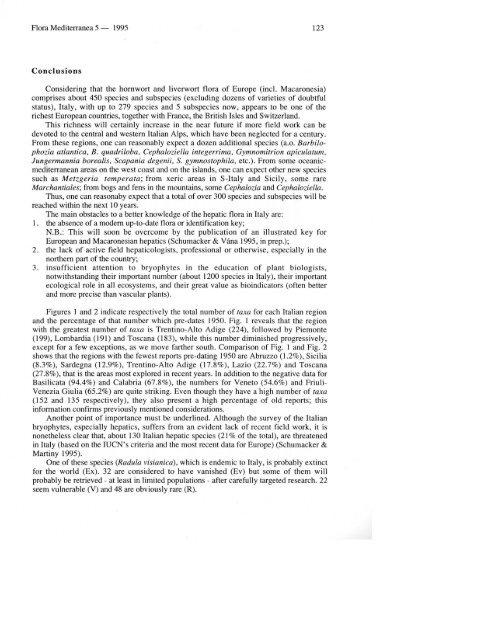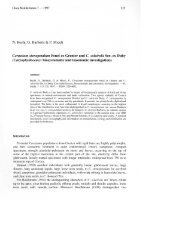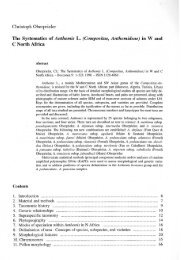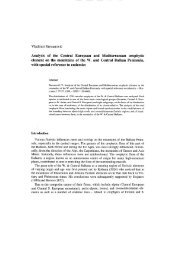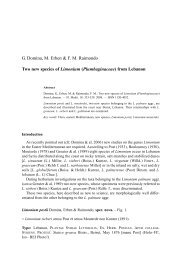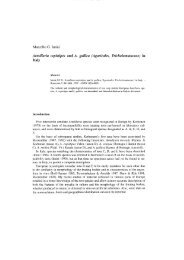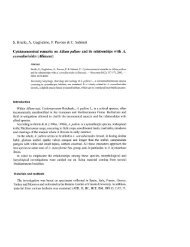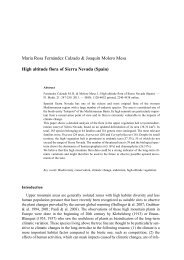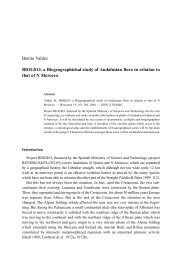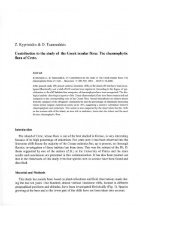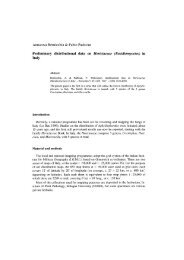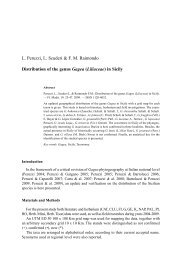Check-list and red-list of the liverworts ... - Herbmedit.org
Check-list and red-list of the liverworts ... - Herbmedit.org
Check-list and red-list of the liverworts ... - Herbmedit.org
Create successful ePaper yourself
Turn your PDF publications into a flip-book with our unique Google optimized e-Paper software.
Flora Mediterranea 5 - 1995 123<br />
ConcIusions<br />
Considering that <strong>the</strong> hornwort <strong>and</strong> Iiverwort flora <strong>of</strong> Europe (incl. Macaronesia)<br />
comprises about 450 species <strong>and</strong> subspecies (excluding dozens <strong>of</strong> varieties <strong>of</strong> doubtful<br />
status), Italy, with up to 279 species <strong>and</strong> 5 subspecies now, appears to be one <strong>of</strong> <strong>the</strong><br />
richest European countries, toge<strong>the</strong>r with France, <strong>the</strong> British Isles <strong>and</strong> Switzerl<strong>and</strong>.<br />
This richness will certainly increase in <strong>the</strong> near future if more field work can be<br />
devoted to <strong>the</strong> centraI <strong>and</strong> western ltalian Alps, which have been neglected for a century.<br />
From <strong>the</strong>se regions, one can reasonably expect a dozen additional species (a.o. Barbilophozia<br />
atlantica, B. quadriloba, Cephaloziella integerrima, Gymnomitrion apiculatum,<br />
Jungermannia borealis, Scapania degenii, S. gymnostophila, etc.). From some oceanicmediterranean<br />
areas on <strong>the</strong> west coast <strong>and</strong> on <strong>the</strong> isl<strong>and</strong>s, one can expect o<strong>the</strong>r new species<br />
such as Metzgeria temperata; from xeric areas in S-Italy <strong>and</strong> Sicily, some rare<br />
Marchantiales; from bogs <strong>and</strong> fens in <strong>the</strong> mountains, some Cephalozia <strong>and</strong> Cephaloziella.<br />
Thus, one can reasonaby expect that a total <strong>of</strong> over 300 species <strong>and</strong> subspecies will be<br />
reached within <strong>the</strong> next 10 years.<br />
The main obstacles to a better knowledge <strong>of</strong> <strong>the</strong> hepatic flora in Italy are:<br />
1 . <strong>the</strong> absence <strong>of</strong> a modem up-to-date flora or identification key;<br />
N.B.: This will soon be overcome by <strong>the</strong> publication <strong>of</strong> an illuwated key for<br />
European <strong>and</strong> Macaronesian hepatics (Schumacker & Vana 1995, in prep.);<br />
2. <strong>the</strong> lack <strong>of</strong> active field hepaticologists, pr<strong>of</strong>essional or o<strong>the</strong>rwise, especially in <strong>the</strong><br />
nor<strong>the</strong>m part <strong>of</strong> <strong>the</strong> country;<br />
3. insufficient attention to bryophytes in <strong>the</strong> education <strong>of</strong> plant biologists,<br />
notwithst<strong>and</strong>ing <strong>the</strong>ir important number (about 1200 species in ltaly), <strong>the</strong>ir important<br />
ecological role in ali ecosystems, <strong>and</strong> <strong>the</strong>ir great value as bioindicators (<strong>of</strong>ten better<br />
<strong>and</strong> more precise than vascular plants).<br />
Figures 1 <strong>and</strong> 2 indicate respectively <strong>the</strong> total number <strong>of</strong> taxa for each ltalian region<br />
<strong>and</strong> <strong>the</strong> percentage <strong>of</strong> that number which pre-dates 1950. Fig. I reveals that <strong>the</strong> region<br />
with <strong>the</strong> greatest number <strong>of</strong> taxa is Trentino-Alto Adige (224), followed by Piemonte<br />
(199), Lombardia (191) <strong>and</strong> Toscana (183), while this number diminished progressively,<br />
except for a few exceptions, as we move far<strong>the</strong>r south. Comparison <strong>of</strong> Fig. I <strong>and</strong> Fig. 2<br />
shows that <strong>the</strong> regions with <strong>the</strong> fewest reports pre-dating 1950 are Abruzzo (1.2%), Sicilia<br />
(8.3%), Sardegna (12.9%), Trentino-Alto Adige (17.8%), Lazio (22.7%) <strong>and</strong> Toscana<br />
(27.8%), that is <strong>the</strong> areas most explo<strong>red</strong> in recent years. In addition to <strong>the</strong> negative data for<br />
Basilicata (94.4%) <strong>and</strong> Calabria (67.8%), <strong>the</strong> numbers for Veneto (54.6%) <strong>and</strong> Friuli<br />
Venezia Giulia (65.2%) are quite striking. Even though <strong>the</strong>y have a high number <strong>of</strong> taxa<br />
(152 <strong>and</strong> 135 respectively), <strong>the</strong>y also present a high percentage <strong>of</strong> old reports; this<br />
information confirms previously mentioned considerations.<br />
Ano<strong>the</strong>r point <strong>of</strong> importance must be underlined. Although <strong>the</strong> survey <strong>of</strong> <strong>the</strong> ltalian<br />
bryophytes, especially hepatics, suffers from an evident lack <strong>of</strong> recent field work, it is<br />
none<strong>the</strong>less clear that, about 130 Italian hepatic species (21 % <strong>of</strong> <strong>the</strong> total), are threatened<br />
in Italy (based on <strong>the</strong> IUCN's criteria <strong>and</strong> <strong>the</strong> most recent data for Europe) (Schumacker &<br />
Martiny 1995).<br />
One <strong>of</strong> <strong>the</strong>se species (Rad~tla visianica), which is endemic to Italy, is probably extinct<br />
for <strong>the</strong> world (Ex). 32 are conside<strong>red</strong> to have vanished (Ev) but some <strong>of</strong> <strong>the</strong>m will<br />
probably be retrieved - at least in limited populations - after carefully targeted research. 22<br />
seem vulnerable (V) <strong>and</strong> 48 are obviously rare (R).


